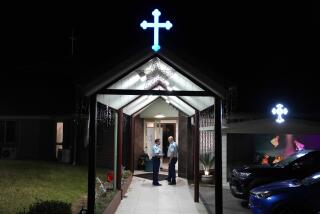Deja vu in Kabul
THE ROADMAP for Afghanistan crafted by the international community in Bonn in December 2001 has been followed to its end. A constitution is in place, and two elections have been held.
Now comes the hard part.
But just as the real struggle for Afghanistan’s future begins, the U.S. Army is strained to the breaking point by the war in Iraq and the Bush administration is reportedly planning to withdraw thousands of troops. It’s hard to imagine a worse idea.
At the edge of the Bonn roadmap, President Hamid Karzai is facing terra cognita in the form of three old, intractable problems: drugs, thugs and insurgents. Opium, warlords and radical Islamism have plagued Afghanistan for decades. Now they are beginning to blend into a perfect storm.
Opium production has grown exponentially since 2001, and by some estimates, as much as 60% of the country’s GDP is either generated by or dependent on it. As many as 90% of Afghanistan’s police chiefs are reportedly involved in or protecting the drug trade. Counter-narcotics efforts to date can be most kindly described as disappointing.
Politically, the good news is women won more seats in parliament in the September elections than the 25% mandated by a constitutional quota. The bad news is that at least half the seats will be held by the same old warlords, ex-communists and hard-line Islamists who helped complete the destruction of Afghanistan begun by the Soviets in 1979 by fighting one another in the 1990s. Among them are Mawlawi Mohammed Islam Mohammedi, the former Taliban governor of Bamian who supervised the destruction of the ancient giant Buddhas; and Ustad Abdul Rasul Sayyaf, cited by Human Rights Watch as a war criminal. Most members of this rogues’ gallery still maintain armed militias, often masquerading as police, and are involved in the drug trade. Few of them support Karzai, making a return of the acrimonious parliamentary gridlock of the 1990s likely.
Completing the sense of deja vu is the insurgency in the south. The Taliban is just the most recent incarnation of a century-old rift between a modernizing urban minority and a conservative, rural Islamist majority. U.S. pronouncements that the Taliban is finished, made annually for the last four years, ring increasingly hollow and demonstrate a profound lack of understanding of Afghanistan. Taliban attacks have grown in number and lethality every year since 2001.
Now, most alarmingly, evidence is growing of a deadly nexus of huge drug profits, the Taliban and a new, globalized jihad. Foreign fighters are appearing in Afghanistan. Afghans are going to Iraq for training, and Afghan drug money appears to be funding it.
What I saw as a State Department political officer in Washington and in the combat zone along the Pakistan border made it clear that the Taliban is waging not an “offensive” but a strategic defensive play. It is delaying meaningful development in the Pushtun tribal belt in the south by killing or frightening away development organizations.
Meanwhile, I heard every day of Taliban agents leaving “night letters” among the villages. The propaganda leaflets warned that the Americans would soon leave Afghanistan, and they threatened deadly reprisals against collaborators as soon as we are gone. So far, their strategy is largely working. Far less is being accomplished in the south than in the north.
Hope for Afghanistan’s future begins with security in the rural areas and the gradual development of the rule of law outside the urban centers. The current level of 18,000 troops represents the lowest per-capita commitment of U.S. forces to a post-conflict mission since World War II. U.S. forces are already stretched too thin on the ground to provide the umbrella of reliable security that would foster development, enable counter-narcotics work, weed out the armed gangs, professionalize the police and defeat the insurgents.
There are only two companies of infantry and no helicopters in all of Paktika province, for example, an area the size of Vermont. I often saw our “quick reaction forces” in Humvees take four hours to traverse 30 miles of boulder-strewn trails to reach the scene of a Taliban attack.
NATO is scheduled to take over full military control in 2006, but it lacks the political will and the capability to conduct a counterinsurgency. Afghan security forces are 10 years from self-sufficiency.
The Pentagon has played a numbers game for three years with the fledgling Afghan army, which looks big on paper but has virtually no ability to move itself, sustain itself or fight by itself. In Paktika, Afghan soldiers were carted to operations in rented civilian trucks and quietly given MREs to keep them from going hungry.
Far from withdrawing troops, the United States needs to deploy at least another full brigade of infantry to the combat zone, together with far more helicopters. It needs to switch to a proven counterinsurgency strategy based on more frequent, less-invasive rural patrols, respect for the local culture, road paving, secure hamlets and rapid airborne response to guerrilla activity.
The uncharted road ahead will be harder and more dangerous than the road behind, and reducing U.S troop levels any time soon would be disastrous.
More to Read
Start your day right
Sign up for Essential California for news, features and recommendations from the L.A. Times and beyond in your inbox six days a week.
You may occasionally receive promotional content from the Los Angeles Times.






